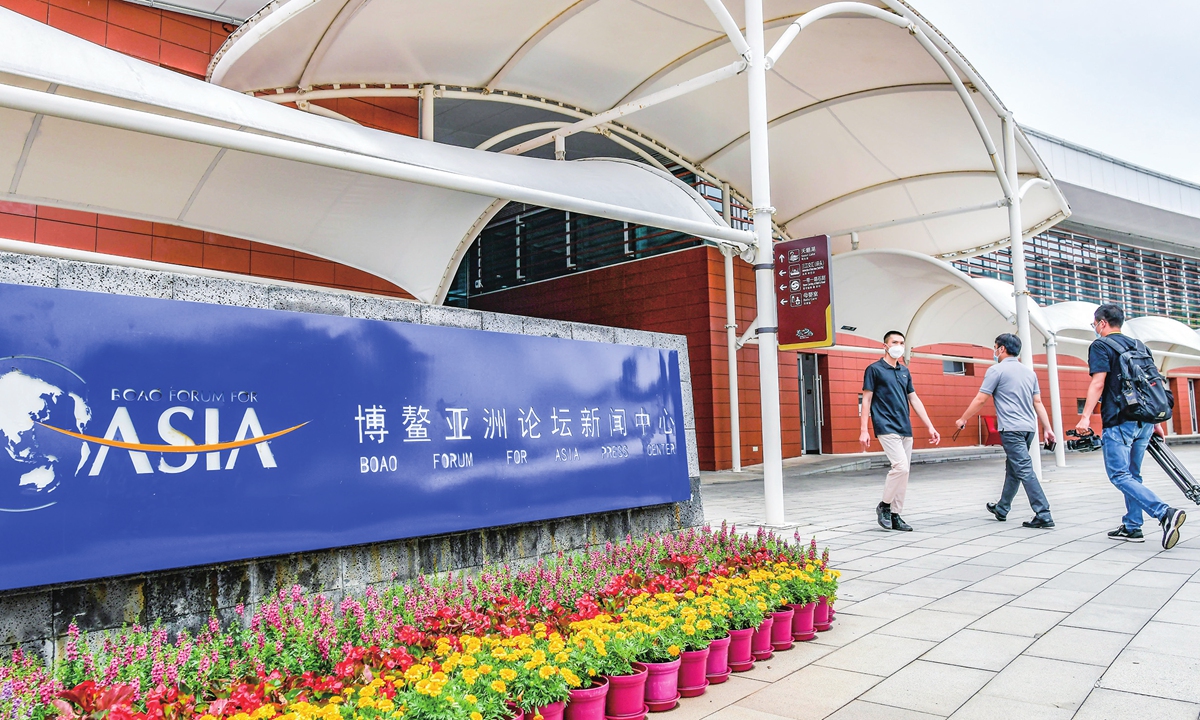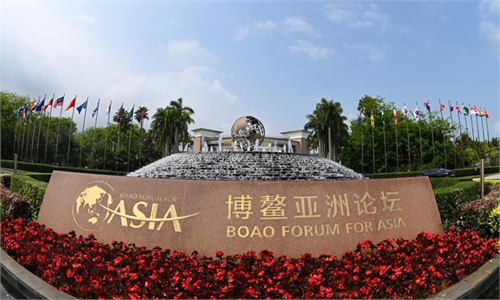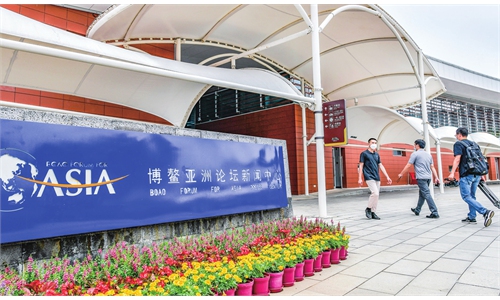
People walk to the media center of the Boao Forum for Asia (BFA) in Boao, South China's Hainan Province on April 19, 2022. The BFA will hold its annual conference from April 20 to 22 in Boao, where participants will discuss the post-pandemic development agenda for Asia and the world. Photo: cnsphoto
The speed of integration among Asian economies has been sustained and even accelerated in some areas despite the COVID-19 pandemic, US interference and other challenges, according to a report published during the Boao Forum for Asia 2022, a major regional cooperation platform that kicked off in Boao, South China's Hainan Province on Wednesday.
The accelerating trend should continue in the next few years with China and the Association of Southeast Asian Nations (ASEAN) being two major promoters of regional integration, experts noted, while warning risks arising from external factors such as the US' attempt to sow chaos in the region.
According to the report, the pace of economic integration in Asia has been "sustained," as shown by statistics in multiple regions. For example, intra-regional trade in the Asia-Pacific region accounted for 58.5 percent of the total regional trade in 2020, the highest share since 1990, the report said.
In this context, the export dependency on Asia for Asian economies reached new high since 2012, while the degree of trade dependence among Asian economies also remained high, the report said.
The report noted that factory integration in Asia picked up after the COVID-19 outbreak, while Asia's direct investment self-dependence rate surged to about 65 percent in 2020, showing that many Asian countries are still dependent on their neighbors for investment.
Trade deals that pushed the region's integration also saw great progress. The Regional Comprehensive Economic Partnership (RCEP) officially came into effect this year, marking the launch of the world's largest free trade area.
Asia's intensifying integration came despite the rising anti-globalization and protectionism initiated by the US in recent years, which analysts said casts the biggest shadow over Asian economic cooperation, and it's important that Asia stays focused without being distracted by external interference.
"The two wheels of globalization are spinning at different speeds. Regionalization is strengthening, and multilateralism is weakening. It's important that the two wheels don't contradict with each other, and it's better if they can complement each other," Zhang Yuyan, director of the Institute of World Economics and Politics at the Chinese Academy of Social Sciences, told the Global Times on Wednesday on the sidelines of the Boao Forum 2022.
The annual forum is taking place from Wednesday to Friday this year, with the theme of "The World in COVID-19 & Beyond: Working Together for Global Development and a Shared Future."
Gu Xiaosong, dean of the ASEAN Research Institute of Hainan Tropical Ocean University, told the Global Times that enhanced cooperation in the region might have been fueled by the COVID-19 pandemic, which left other regions in the world under more severe influence from the virus while Asia was relatively stable and able to carry on business.
It has also been spurred by geographic advantages, as it's easier for Asian economies to ship products to their neighbors, particularly after the establishment of more and more connecting infrastructure facilities like the China-Laos Railway, he said.
"China and ASEAN are surely two 'forces of gravity' behind the region's cooperation. In particular, China proposes the idea of integration, and ASEAN is like a driver who helps coordinate the economies involved and push the concept into reality," Gu said.
However, experts also warned that Asia's integration might be challenged by external factors, including the Ukraine crisis and the US' efforts to isolate China from other economies.
Singaporean scholar Kishore Mahbubani said on Wednesday that in the current complex global situation, there are two competing visions of the Indo-Pacific region, one dominated by the US that tries to leave China out of the region and one led by the RCEP that has China in the system.
"The future lies in building these two visions together," he said at the Boao Forum.
Gu nevertheless predicted that the trend of Asian integration will go further, as many countries have already seen the benefits of such an initiative, and as infrastructure continues to be built that facilitates Asian economies' interaction.
The China-Laos Railway, for example, might be extended to Thailand or even to Malaysia and Singapore in the next few years, which will largely boost trade among those economies, he said.




